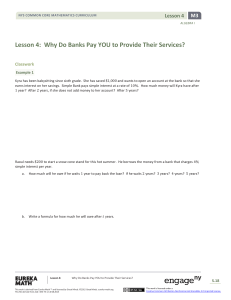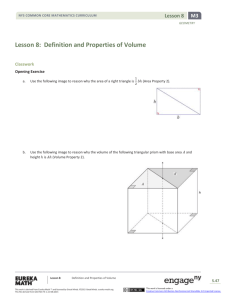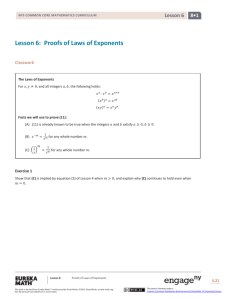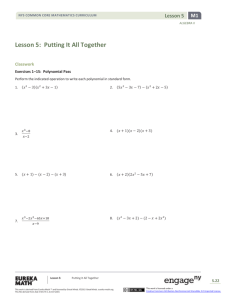Algebra II Module 1, Topic D, Lesson 37: Student Version
advertisement
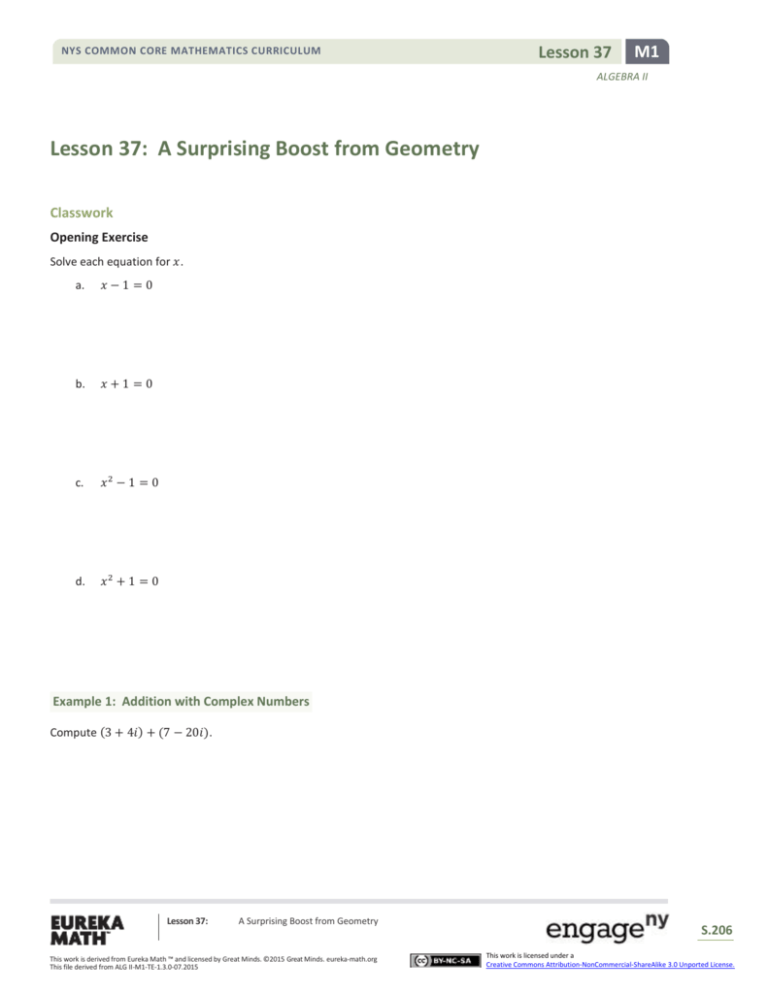
NYS COMMON CORE MATHEMATICS CURRICULUM Lesson 37 M1 ALGEBRA II Lesson 37: A Surprising Boost from Geometry Classwork Opening Exercise Solve each equation for 𝑥. a. 𝑥−1=0 b. 𝑥+1=0 c. 𝑥2 − 1 = 0 d. 𝑥2 + 1 = 0 Example 1: Addition with Complex Numbers Compute (3 + 4𝑖) + (7 − 20𝑖). Lesson 37: A Surprising Boost from Geometry This work is derived from Eureka Math ™ and licensed by Great Minds. ©2015 Great Minds. eureka-math.org This file derived from ALG II-M1-TE-1.3.0-07.2015 S.206 This work is licensed under a Creative Commons Attribution-NonCommercial-ShareAlike 3.0 Unported License. NYS COMMON CORE MATHEMATICS CURRICULUM Lesson 37 M1 ALGEBRA II Example 2: Subtraction with Complex Numbers Compute (3 + 4𝑖) − (7 − 20𝑖). Example 3: Multiplication with Complex Numbers Compute (1 + 2𝑖)(1 − 2𝑖). Example 4: Multiplication with Complex Numbers Verify that −1 + 2𝑖 and −1 − 2𝑖 are solutions to 𝑥 2 + 2𝑥 + 5 = 0. Lesson 37: A Surprising Boost from Geometry This work is derived from Eureka Math ™ and licensed by Great Minds. ©2015 Great Minds. eureka-math.org This file derived from ALG II-M1-TE-1.3.0-07.2015 S.207 This work is licensed under a Creative Commons Attribution-NonCommercial-ShareAlike 3.0 Unported License. Lesson 37 NYS COMMON CORE MATHEMATICS CURRICULUM M1 ALGEBRA II Lesson Summary Multiplication by 𝑖 rotates every complex number in the complex plane by 90° about the origin. Every complex number is in the form 𝑎 + 𝑏𝑖, where 𝑎 is the real part and 𝑏 is the imaginary part of the number. Real numbers are also complex numbers; the real number 𝑎 can be written as the complex number 𝑎 + 0𝑖. Numbers of the form 𝑏𝑖, for real numbers 𝑏, are called imaginary numbers. Adding two complex numbers is analogous to combining like terms in a polynomial expression. Multiplying two complex numbers is like multiplying two binomials, except one can use 𝑖 2 = −1 to further write the expression in simpler form. Complex numbers satisfy the associative, commutative, and distributive properties. Complex numbers allow us to find solutions to polynomial equations that have no real number solutions. Problem Set 1. Locate the point on the complex plane corresponding to the complex number given in parts (a)–(h). On one set of axes, label each point by its identifying letter. For example, the point corresponding to 5 + 2𝑖 should be labeled 𝑎. a. 5 + 2𝑖 b. 3 − 2𝑖 c. −2 − 4𝑖 d. −𝑖 e. 1 2 +𝑖 f. √2 − 3𝑖 g. 0 h. − + 3 2 √3 2 𝑖 Lesson 37: A Surprising Boost from Geometry This work is derived from Eureka Math ™ and licensed by Great Minds. ©2015 Great Minds. eureka-math.org This file derived from ALG II-M1-TE-1.3.0-07.2015 S.208 This work is licensed under a Creative Commons Attribution-NonCommercial-ShareAlike 3.0 Unported License. NYS COMMON CORE MATHEMATICS CURRICULUM Lesson 37 M1 ALGEBRA II 2. 3. 4. 5. Express each of the following in 𝑎 + 𝑏𝑖 form. a. (13 + 4𝑖) + (7 + 5𝑖) b. (5 − 𝑖) − 2(1 − 3𝑖) c. ((5 − 𝑖) − 2(1 − 3𝑖)) d. (3 − 𝑖)(4 + 7𝑖) e. (3 − 𝑖)(4 + 7𝑖) − ((5 − 𝑖) − 2(1 − 3𝑖)) 2 Express each of the following in 𝑎 + 𝑏𝑖 form. a. (2 + 5𝑖) + (4 + 3𝑖) b. (−1 + 2𝑖) − (4 − 3𝑖) c. (4 + 𝑖) + (2 − 𝑖) − (1 − 𝑖) d. (5 + 3𝑖)(3 + 5𝑖) e. −𝑖(2 − 𝑖)(5 + 6𝑖) f. (1 + 𝑖)(2 − 3𝑖) + 3𝑖(1 − 𝑖) − 𝑖 Find the real values of 𝑥 and 𝑦 in each of the following equations using the fact that if 𝑎 + 𝑏𝑖 = 𝑐 + 𝑑𝑖, then 𝑎 = 𝑐 and 𝑏 = 𝑑. a. 5𝑥 + 3𝑦𝑖 = 20 + 9𝑖 b. 2(5𝑥 + 9) = (10 − 3𝑦)𝑖 c. 3(7 − 2𝑥) − 5(4𝑦 − 3)𝑖 = 𝑥 − 2(1 + 𝑦)𝑖 Since 𝑖 2 = −1, we see that 𝑖 3 = 𝑖 2 ⋅ 𝑖 = −1 ⋅ 𝑖 = −𝑖 𝑖 4 = 𝑖 2 ⋅ 𝑖 2 = −1 ⋅ −1 = 1. Plot 𝑖, 𝑖 2 , 𝑖 3 , and 𝑖 4 on the complex plane, and describe how multiplication by each rotates points in the complex plane. Lesson 37: A Surprising Boost from Geometry This work is derived from Eureka Math ™ and licensed by Great Minds. ©2015 Great Minds. eureka-math.org This file derived from ALG II-M1-TE-1.3.0-07.2015 S.209 This work is licensed under a Creative Commons Attribution-NonCommercial-ShareAlike 3.0 Unported License. NYS COMMON CORE MATHEMATICS CURRICULUM Lesson 37 M1 ALGEBRA II 6. 7. Express each of the following in 𝑎 + 𝑏𝑖 form. a. 𝑖5 b. 𝑖6 c. 𝑖7 d. 𝑖8 e. 𝑖 102 Express each of the following in 𝑎 + 𝑏𝑖 form. a. (1 + 𝑖)2 b. (1 + 𝑖)4 c. (1 + 𝑖)6 8. Evaluate 𝑥 2 − 6𝑥 when 𝑥 = 3 − 𝑖. 9. Evaluate 4𝑥 2 − 12𝑥 when 𝑥 = 10. Show by substitution that 3 𝑖 − . 2 2 5−𝑖√5 5 is a solution to 5𝑥 2 − 10𝑥 + 6 = 0. 11. a. Evaluate the four products below. Evaluate √9 ⋅ √4. Evaluate √9 ⋅ √−4. Evaluate √−9 ⋅ √4. Evaluate √−9 ⋅ √−4. b. Suppose 𝑎 and 𝑏 are positive real numbers. Determine whether the following quantities are equal or not equal. √𝑎 ∙ √𝑏 and √−𝑎 ∙ √−𝑏 √−𝑎 ∙ √𝑏 and √𝑎 ∙ √−𝑏 Lesson 37: A Surprising Boost from Geometry This work is derived from Eureka Math ™ and licensed by Great Minds. ©2015 Great Minds. eureka-math.org This file derived from ALG II-M1-TE-1.3.0-07.2015 S.210 This work is licensed under a Creative Commons Attribution-NonCommercial-ShareAlike 3.0 Unported License.


